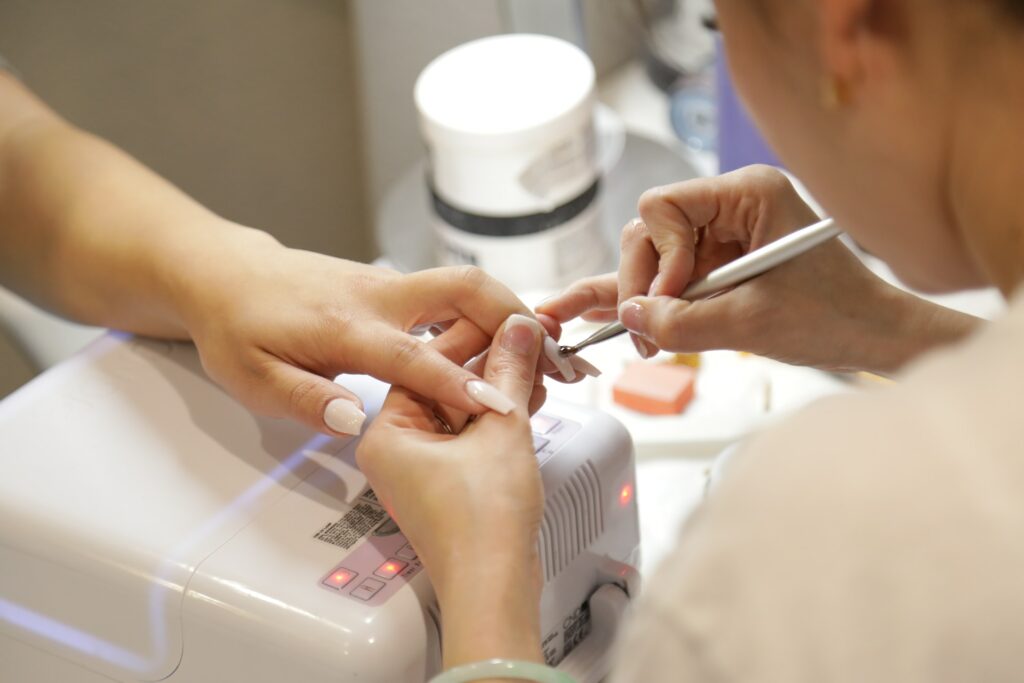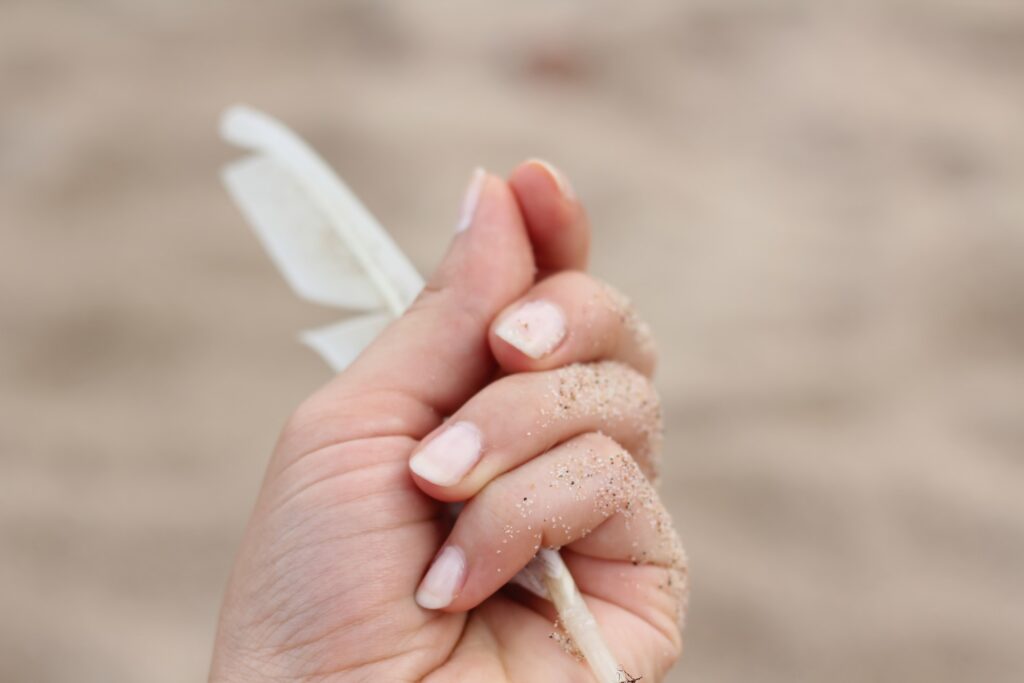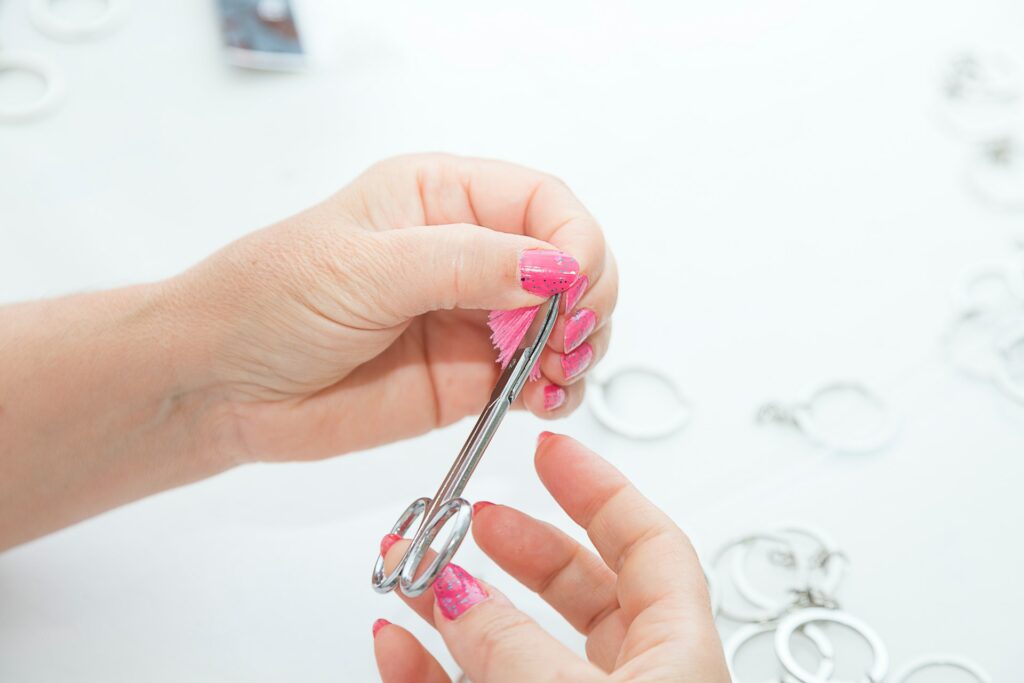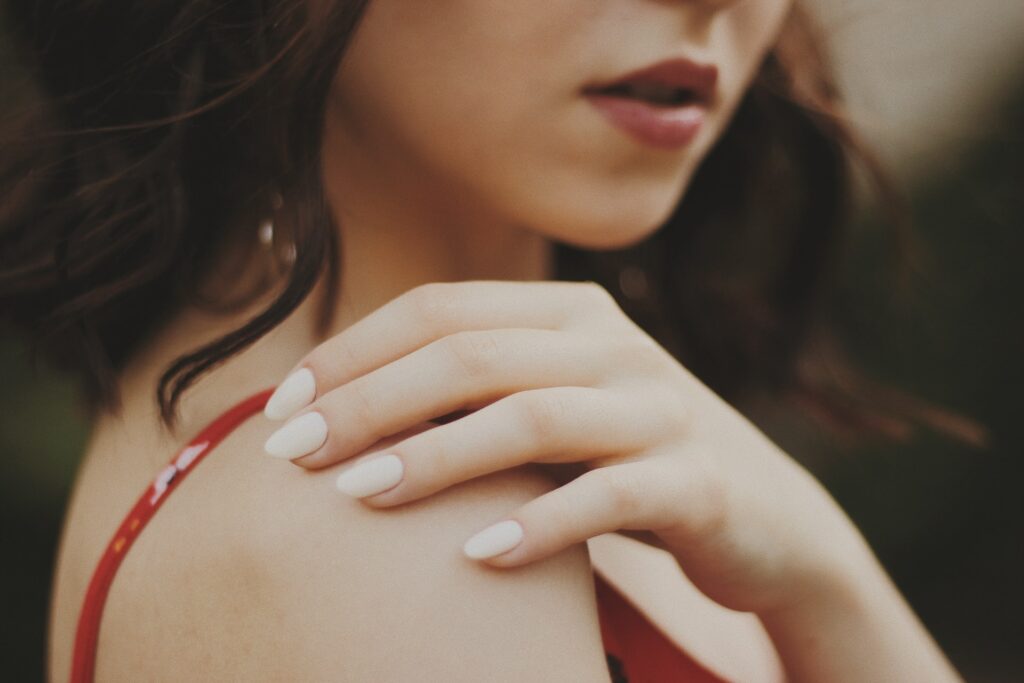Table of Contents
Polygel nails are a game changer – they’re flexible, durable, and oh-so-gorgeous! But when they suddenly pop off, it’s like a high note going off-key at a concert – an unexpected hiccup that can throw your style off balance. As someone who’s experienced (and survived) the heartache of premature nail detachments and spent countless hours diving into the depths of nail science, I have your back!
In this post, we will navigate the complex labyrinth of reasons behind the spontaneous popping off of your poly gel nails, from preparation errors to environmental factors and everything in between. We’ll explore how each component – the natural nail, the polyol, and the curing process – has its role in your nail ensemble’s harmony (or disharmony).
By the end of our nail journey, you’ll be a poly gel expert and a nail detective, able to pinpoint any error in your routine and make necessary tweaks for long-lasting, pop-off-proof nails. Prepare to ascend the ranks of nail-guru-dom. Shall we dive in, dear nail enthusiasts? Let’s get our hands dirty (in a manicured way, of course)!
Decoding Polygel Nails

Let’s start by shedding some light on what poly gel nails are for the uninitiated. Think of them as the super-cool love child of acrylic and hard-gel nails. They have this semi-solid, flexible consistency, making them a breeze to apply and incredibly durable, which is perfect for those of us dealing with weak or brittle nails.
Once upon a time, I tried poly gel nails on a whim, and boy, was I smitten! They’re applied using a brush and a light curing device, and the best part is they can be shaped and molded to your heart’s content. I remember how easily they could be removed, leaving my natural nails safe and unharmed, making them an absolute go-to for those who love mixing and matching our looks.
Plus, they’re practically bulletproof. You can go as long as you like without worrying about chips or cracks. Quite the little nail champions, aren’t they?
Understanding Dual Form with Polygel Nails
If you’re a nail enthusiast like me, you’ve likely come across the term ‘dual form.’ This technique uses two forms to create a smooth and seamless transition from your natural nail to your stylish poly gel extensions.
Once, I decided to try the coffin nail look – super long and dramatic. The dual form technique rescued me, supporting my fancy new extensions. It was perfect – the finish was smooth, even, and most importantly, it lasted way longer than I expected.
The Mystery of the Popping Polygel Nails
Despite being amazing, poly gel nails can sometimes become mini heartbreaks when they unexpectedly pop off. Trust me, I’ve been there – right in the middle of a dinner date! The culprit can be a faulty application process, insufficient primer, a too-thick layer of poly gel, or rushing the drying process.
Then there’s the question of nail care. You’d be surprised how often we overlook regular filing and buffing. It’s like inviting a ton of dirt and oil onto your nails, which weakens the adhesive bond. And, if your poly gel formula isn’t up for the daily hustle, it might be time to consider a sturdier product.
Let’s dive into why these little things might pop off sooner than you’d like…
The Adhesion Dilemma
The main reason behind poor adhesion can be traced back to several factors. You may have used the wrong primer or forgot to use primer at all. Always remember to use the primer included in your poly gel nail kit. It works wonders for ensuring a solid bond between your nail and the gel base coat.
Once I forgot to use a slip solution after applying the poly gel and before the curing process. Let’s say the results weren’t pretty. This essential step keeps your poly gel from slipping or moving while being cured under a UV light nail lamp.
Proper nail prep is also crucial. Think of it as prepping your canvas before painting. A clean nail bed is essential to ensure strong adhesion. Once, I rushed through my nail prep process, and let’s say, lifting and weak bonding became my uninvited guests for the week.
And last but not least, if your poly gel nails aren’t cured for the right amount of time, they can quickly start peeling off. Ensure the LED light is held 1-2 cm away from the nail, and be patient for two minutes. Trust me, good things come to those who wait.
The Importance of Proper Preparation

Polygel nails are an innovative trend, offering you strong, long, and beautiful nails. But just like your skin before makeup, your nails must be prepped just right. And guess what? I’ve got the scoop on how to do it!
Start with a blank canvas. Use a nail brush and a non-acetone gel polish remover to ensure your natural nails are clean, oil-free, and dust-free. Fun fact: I once used an acetone-based remover, which weakened my nails.
After a thorough cleaning, use a slip solution on your natural nails. This creates a barrier preventing the polygel nails from lifting or popping off. Then, buff your nail surface so they’re ready for the polyol. Once, I tried to skip this step, thinking it wasn’t necessary, and let’s say my nails had a mind of their own.
Finally, it’s time for your UV light to work magic and cure the poly gel. Let the light pass over each nail several times for a secure bond. If your poly gel nails pop off despite this, don’t panic. Just re-clean, buff, and prep again. And remember, no acetone-based products! Trust me, it’ll only weaken your nails.
Beware of Poor Application Techniques
Are you using the right amount of product when applying your poly gel nails? Too much product can create tension, causing the pin to say sayonara way sooner. And a poorly cured bond means the nail may not harden correctly, leading to—you guessed it—more premature popping.
I’ve learned that rushing through the nail prep process and failing to remove all dirt, oils, and dead skin can also lead to premature popping. And if you mess up the order of steps during the application, it’s like setting up your nails to fail.
The key to a flawless application? Patience and attention to detail. Taking your time and being thorough during application means stronger, longer-lasting nails. It’s a win-win!
Too Much Moisture? Time to Dry Out!

As a beauty blogger, I assure you that poly gel nails are a game-changer. But frequent popping off could mean that there’s too much moisture during the polymerization process. Thankfully, I’ve got a few tips to help you out.
Start by using a slip solution. This reduces the stickiness of the polyol, preventing it from adhering too much to your natural nails. Make sure you use a soft nail brush for this.
Still, needs to be fixed? A UV light might be your savior. It helps to cure the poly gel, reducing the risk of lifting or coming off due to moisture. But remember, follow the instructions carefully for the best results.
How to Prevent Polygel Pops
Avoiding the poly gel pop-off party is more straightforward than it seems. Begin with a meticulous nail prep routine, removing all polish or residue. Buff your nails to create a smooth surface, and push back and trim those cuticles. Use rubbing alcohol to sanitize your nails for a spotless canvas.
Once prepped, apply the poly gel carefully, following the instructions to a T. Apply thin layers and cap the nail’s free edge. After curing under the LED/UV light, add a top coat for that extra layer of protection.
Finally, ensure your nails are dry before applying hand cream or any water-related activities. I once did the dishes right after a manicure and quickly learned how wet or oily nails can weaken the bond of the product, leading to premature popping off.
Keep Calm and Fix On Reattaching a Polygel Nail
First, resist the urge to glue the runaway nail back on immediately. Cleanliness is vital, darling. Use an acetone-free nail cleanser (I’ve learned that acetone can damage your nails) and a lint-free wipe to cleanse the detached and natural nails.
Next, a gentle buff is for both nails. This increases the surface area and provides a better grip for reattachment.
Now comes the adhesive, and not just any adhesive. Opt for a specific nail adhesive designed for poly gel nails to ensure a strong and secure bond. Once, I used regular glue, and let’s say it wasn’t pretty!
Time to reunite the separated duo. Press the poly gel nail firmly onto the natural nail, and wait a few minutes before using your hand. If you’re still facing issues, don’t hesitate to call in a pro. A professional manicurist or nail technician can help resolve the problem effectively.
Secrets to Long-lasting Polygel Nails

Who doesn’t want their stunning poly gel nails to last longer? And trust me, with a few insider tips, you can maintain that fabulous look for a while longer.
Ensure that the gel bonds well with the nail bed during application. This ensures a secure base, which equals long-lasting nails. Clean your nails before application, and make sure to complete the primer or bonder recommended.
Try to avoid water exposure, as it can weaken your nails. Also, a protective sealant or topcoat post-application protects your nails from chipping or cracking. And lastly, keep an eye out for signs of wear and tear, and reapply the sealant when needed.
Tips for Happy, Healthy Polygel Nails

Taking care of poly gel nails is crucial to prevent them from popping off. Start with a proper application process and remember, less is more when it comes to poly gel on the nail bed.
Use a compatible base coat and top coat for best results. I learned that the hard way when my incompatible topcoat and poly gel led to a manicure disaster!
Keeping your hands clean and moisturized before poly gel application can help create a stronger bond. Be careful with acetone-based products; they can weaken the adhesive and lead to premature nail lifting.
Regular maintenance is the key to a fabulous manicure. Check your nails every few days for any lifting, and use a manicure stick to press down any edges that may have lifted.
Are you still facing issues? It might be time to seek professional help. The cause could be an underlying health issue or a problem with the application technique. A professional will be able to identify and solve the problem.
Polygel, Meet Nail: A Love Story
Polygel nails, when done right, can feel like the fairy godmother of nail extensions – quick, easy, and oh-so-natural. But sometimes, your poly gel might act more like a rebellious teenager and refuse to stick. A few reasons could be at play here.
Firstly, your nails might need to be fully prepared. I remember my first time with Polygel – I was so excited to start that I skipped the crucial prep step of using a nail dehydrator or primer to smoothen the surface. Trust me, without a smooth, even surface, your poly gel is more likely to say “thanks, but no thanks” to sticking around.
Then, there’s the product consistency. It needs to be just right. Like Goldilocks, too thin and it’s hard to apply; too thick and it may crack during application and curing. Your poly gel should be thick enough to easily scoop and shape the nail.
And let’s remember the curing lamp. Is it warm enough? If it’s too low, the poly gel might not cure properly. Been there, done that, and it wasn’t fun!
How Long Do Polygel Nails Really Last?
So, you’ve got your poly gel nails on (finally!), and now you’re wondering how long you get to flaunt them. With proper care, these beauties can last up to six weeks! Yep, you read that right. But, it does require some upkeep.
Maintenance is vital to ensure your nails stay fabulous for as long as possible. I have a little routine I follow every week – lightly buff the tips and nourish the nail bed with good-quality cuticle oil.
This has helped keep my nails strong and chipping-free. Plus, it’s a little excuse for some self-care. And let’s remember the hand lotion. Apply it daily to keep the natural nails hydrated, and say goodbye to dryness or cracking around the edges of the extensions.
So, lovelies, with a bit of patience and proper care, your poly gel nails will keep their fresh-off-the-salon look for weeks. Now, that’s what I call nail magic!
What Are The Common Reasons Behind Polygel Nails Popping Off Unexpectedly?
You’ve just given yourself a fresh set of polygel nails, they look fabulous, and BAM! – a nail pops off. So frustrating, right? Well, let’s delve into this issue together and figure out some of the common reasons why this happens:
1. Prepping Problems: The preparation phase is the first and perhaps the most common reason. Remember, your natural nails must be squeaky clean and free from oils, dirt, or dust. If they’re not, it could result in your polygel nails lifting or popping off. I always use a non-acetone nail polish remover and a nail brush for a deep clean. Acetone-based removers can weaken the nail surface, so they’re a no-no for me.
2. Incorrect Application: This one’s tricky! Poor application techniques can sabotage your polygel dreams even with the right prep. Applying too much product, not properly curing the bond, or even going out of order with the application steps can lead to nail-popping issues. So, remember to take your time, be patient and apply the product carefully and measuredly.
3. Moisture Mayhem: We’re sometimes too human despite our best efforts. I remember once, after giving myself a gorgeous set of polygel nails, I decided to do some washing up without gloves – big mistake! Too much moisture in your day-to-day activities can make it difficult for the polygel to adhere correctly to your nails and lead to lifting or popping off.
4. Health-Related Hitch: Lastly, but importantly, if you’ve tried everything and your polygel nails are still popping off frequently, it might be due to an underlying health issue like a fungal infection or dehydration. If that is the case, please visit a professional.
So, there you have it. From my experience and professional knowledge, these are the most common reasons for polygel nails to pop off. Always give yourself the best shot at a fabulous and lasting manicure by prepping correctly, taking time with your application, and protecting your hands from unnecessary moisture. And most importantly, remember to listen to what your nails might tell you about your health.
How Important Is Proper Nail Preparation Before Applying Polygel Nails?
I can’t stress this enough: the prep work is the backbone of a flawless, long-lasting polygel manicure. I’ve learned this the hard way!
Why is Preparation so Important?
If you’ve ever painted a wall, you’ll understand the concept. To get a smooth and even paint application, you must clean and smooth the wall first, right? The same principle applies to our nails.
Polygel adheres best to a clean, buffed surface. This means any oil, dirt, or old nail polish on your nails can prevent the polygel from sticking correctly. Let’s be real – nothing is more frustrating than crafting a beautiful set of polygel pins, only for them to lift or chip due to improper preparation. I’ve been there, done that, and it’s not fun!
The Right Way to Prep:
Prepping your nails for polygel application involves a few crucial steps. Start with clean, dry nails. I like to use an acetone-free nail polish remover and then wash my hands thoroughly.
Next, buff your nails gently. Buffing creates a slightly rough surface, increasing the surface area for the polygel to adhere to. Remember, gentle is the keyword here. Overbuffing can weaken the nails, and we don’t want that.
After buffing, use a lint-free wipe to remove dust or particles from your nails. Finally, some brands recommend using a nail dehydrator or primer. These products help to remove any remaining oil on the nail surface and create an even better feeling for the polygel.
So, lovelies, proper nail preparation is vital. It may seem like a lot of extra work, but it’s worth it for a beautiful, long-lasting polygel manicure. Plus, with practice, it becomes second nature.
What Is The Dual Form Technique And How Does It Work With Polygel Nails?
This method is a game-changer, trust me! It’s quick, efficient, and the results are nothing short of professional salon quality.
What’s the Dual Form Technique?
Picture this – creating perfect, flawless nails without sculpting or filing the polygel. Sounds too good to be true? Welcome to the dual-form technique!
Dual forms, also known as nail molds or extensions, are clear, reusable plastic molds that fit over your natural nails. They are little guides to help you shape and apply the polygel.
How Does it Work with Polygel Nails?
The beauty of the dual form technique lies in its simplicity. First, you’ll pick the right size form for each of your nails. These forms usually come in various sizes so that you can find a good fit.
Next, you apply a small amount of polygel into the dual form. Using a brush (dipped in slip solution or isopropyl alcohol), pat the polygel into the state, shaping it to the desired thickness and length. Remember the golden rule here: less is more. You want a nail that is thick enough and lighter!
Once you’re happy with the shape, gently press the form onto your nail. Any excess polygel that squeezes out can be smoothed away with your brush.
Then comes the magic – curing! Slide your hand under the UV/LED lamp, and the light will cure (harden) the polygel, leaving you with a perfectly shaped and smooth nail.
After curing, you pop off the dual form (which can be cleaned and reused), and voilà! Beautifully sculpted nails with minimal effort. Add your top coat, and you’re ready to dazzle!
I remember the first time I tried this technique, I was so thrilled with the results – it felt like I’d discovered a secret nail hack! So, if you’re looking for a fuss-free, salon-quality method for applying polygel nails, the dual form technique is worth a try.
Conclusion
And that wraps our poly gel nail saga, my lovely readers! Remember, as with all beauty treatments, the devil is in the details. Proper preparation is essential – a good nail dehydrator or primer can make all the difference for those stubborn poly gel nails that don’t want to stick. Paying attention to the product’s consistency and ensuring your curing lamp is at the right temperature are crucial steps toward your perfect poly gel manicure. With the proper care, including weekly buffing, nourishing with cuticle oil, and daily moisturizing, your poly gel nails can stay fabulous for up to six weeks!
But remember, even the best beauty experts have their off days (trust me, I’ve been there!). So, if things don’t go as planned, don’t stress. Every mistake is a chance to learn, and every experience brings us closer to nailing the perfect manicure. Like beauty, it’s all about the journey, not just the destination. So go ahead, try poly gel nails, and remember to enjoy every step of your beauty adventure. Keep shining and keep experimenting because you are your own best beauty expert! Until next time!
Feature image by Roman Kraft on Unsplash




